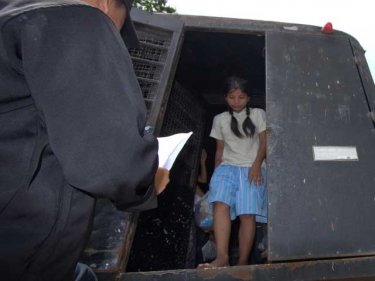UP CLOSE, the container truck in which 54 Burmese suffocated earlier this month is still touched with tragedy.
Inside, scattered across the floor, are pieces of clothing, flip-flops and a couple of cigarette lighters.
It's hard to imagine what it must have been like that night, with 120 people gasping for air. There cannot have been any room to move.
Once the doors are closed, and the lock is slid in place, there is no way out.
The container truck is being kept as evidence at Suksamlan police station, 240 kilometres north of Phuket, for the case against the alleged traffickers responsible for those horrible deaths.
Nearby are eight impounded pickups, a couple of them new vehicles with red provisional plates. Burmese were found concealed under payloads in them by police at checkpoints.
The rear of one pickup is craftily covered with tin cans. It would be impossible to spot the Burmese inside, until you dropped the tray.
In the case of this pickup, 10 Burmese lay tightly packed, hidden under the cans.
Phuketwan travelled north to Ranong on the border with Burma recently, hoping to talk to the survivors of the container tragedy.
Most of the adult survivors, having served their 10 day punishment in Ranong Jail, where the suspected traffickers are also being held, were due to be released.
Instead of being freed and trucked to the border, the survivors were taken to the Ranong Immigration centre to join the 14 underage survivors who are already there.
The survivors are regarded as ''victims and witnesses'' and as such, are being held for the trials of the accused.
Once the prosecution has established its case, some may be allowed back to Burma. There is no indication as yet how long they will be held.
The youth of the people involved is what strikes you as they move on departure from the prison to the wire mesh trucks, and on arrival from the wire mesh trucks to the detention centre.
We talked to Burmese who live and work legally in Ranong and learned much about their own trials.
We also learned one interesting detail about the container and its human cargo. These people were, we were told by Immigration officials, all legally in Ranong and entitled to work there.
But life is hard. Workers in one local shrimp factory do not have a day off. There are plenty of others to replace them if there are problems.
So Ranong is not a great place to be Burmese.
Hence the cargo of people in the container, and the 600,000 baht that was paid to what the Chinese call ''snakeheads'' for their sardine-can journey south.
Phuketwan was told that only by moving beyond the boundaries of Ranong did the people in the truck become illegal immigrants.
That's the motive for the subterfuge, and why they stepped into the air-tight container that night.
Those 54 people died for a dream. They suffocated because they longed for a better life in Phuket.
Inside, scattered across the floor, are pieces of clothing, flip-flops and a couple of cigarette lighters.
It's hard to imagine what it must have been like that night, with 120 people gasping for air. There cannot have been any room to move.
Once the doors are closed, and the lock is slid in place, there is no way out.
The container truck is being kept as evidence at Suksamlan police station, 240 kilometres north of Phuket, for the case against the alleged traffickers responsible for those horrible deaths.
Nearby are eight impounded pickups, a couple of them new vehicles with red provisional plates. Burmese were found concealed under payloads in them by police at checkpoints.
The rear of one pickup is craftily covered with tin cans. It would be impossible to spot the Burmese inside, until you dropped the tray.
In the case of this pickup, 10 Burmese lay tightly packed, hidden under the cans.
Phuketwan travelled north to Ranong on the border with Burma recently, hoping to talk to the survivors of the container tragedy.
Most of the adult survivors, having served their 10 day punishment in Ranong Jail, where the suspected traffickers are also being held, were due to be released.
Instead of being freed and trucked to the border, the survivors were taken to the Ranong Immigration centre to join the 14 underage survivors who are already there.
The survivors are regarded as ''victims and witnesses'' and as such, are being held for the trials of the accused.
Once the prosecution has established its case, some may be allowed back to Burma. There is no indication as yet how long they will be held.
The youth of the people involved is what strikes you as they move on departure from the prison to the wire mesh trucks, and on arrival from the wire mesh trucks to the detention centre.
We talked to Burmese who live and work legally in Ranong and learned much about their own trials.
We also learned one interesting detail about the container and its human cargo. These people were, we were told by Immigration officials, all legally in Ranong and entitled to work there.
But life is hard. Workers in one local shrimp factory do not have a day off. There are plenty of others to replace them if there are problems.
So Ranong is not a great place to be Burmese.
Hence the cargo of people in the container, and the 600,000 baht that was paid to what the Chinese call ''snakeheads'' for their sardine-can journey south.
Phuketwan was told that only by moving beyond the boundaries of Ranong did the people in the truck become illegal immigrants.
That's the motive for the subterfuge, and why they stepped into the air-tight container that night.
Those 54 people died for a dream. They suffocated because they longed for a better life in Phuket.




